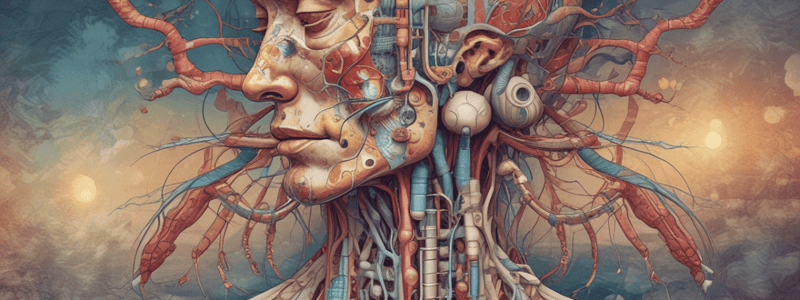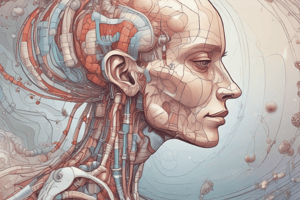Podcast
Questions and Answers
What percentage of diabetes cases are attributed to DM1?
What percentage of diabetes cases are attributed to DM1?
- 20-30%
- 5-10% (correct)
- 90-95%
- 50-60%
In DM1, the pancreas produces some insulin.
In DM1, the pancreas produces some insulin.
False (B)
What are the three main manifestations of DM1?
What are the three main manifestations of DM1?
Polyuria, Polydipsia, Polyphagia
In DM2, the beta cells are _______________________.
In DM2, the beta cells are _______________________.
Match the following terms with their descriptions:
Match the following terms with their descriptions:
What is a common risk factor for developing DM2?
What is a common risk factor for developing DM2?
Insulin resistance is a characteristic of DM1.
Insulin resistance is a characteristic of DM1.
What is the result of fat metabolism in DM1?
What is the result of fat metabolism in DM1?
In DM2, excess ____________________________________ production contributes to hyperglycemia.
In DM2, excess ____________________________________ production contributes to hyperglycemia.
What is a characteristic of Metabolic Syndrome?
What is a characteristic of Metabolic Syndrome?
What is the main function of the hypothalamus?
What is the main function of the hypothalamus?
The pineal gland is located near the hypothalamus and pituitary gland.
The pineal gland is located near the hypothalamus and pituitary gland.
What is the primary function of the anterior pituitary hormone TSH?
What is the primary function of the anterior pituitary hormone TSH?
The hormone _______ is released by the posterior pituitary and stimulates uterine contractions and ejection of milk.
The hormone _______ is released by the posterior pituitary and stimulates uterine contractions and ejection of milk.
Match the following glands with their primary functions:
Match the following glands with their primary functions:
What is the effect of excessive ADH secretion?
What is the effect of excessive ADH secretion?
The pancreas is under hypothalamus control.
The pancreas is under hypothalamus control.
What is the primary function of insulin?
What is the primary function of insulin?
The hormone _______ is released by the anterior pituitary and stimulates the adrenal cortex to release cortisol.
The hormone _______ is released by the anterior pituitary and stimulates the adrenal cortex to release cortisol.
What is the term for the 24-hour period of diurnal variation of cortisol levels?
What is the term for the 24-hour period of diurnal variation of cortisol levels?
Which gland is often referred to as the 'master gland' due to its control over many other glands and cells?
Which gland is often referred to as the 'master gland' due to its control over many other glands and cells?
The hypothalamus is responsible for managing the autonomic nervous system and hormones.
The hypothalamus is responsible for managing the autonomic nervous system and hormones.
What is the primary function of melatonin produced by the pineal gland?
What is the primary function of melatonin produced by the pineal gland?
The hypothalamus stimulates the release of ______________________ from the anterior pituitary gland, which in turn stimulates the thyroid gland.
The hypothalamus stimulates the release of ______________________ from the anterior pituitary gland, which in turn stimulates the thyroid gland.
Match the following anterior pituitary hormones with their functions:
Match the following anterior pituitary hormones with their functions:
The pancreas is under hypothalamus control.
The pancreas is under hypothalamus control.
What is the primary function of insulin released by the pancreas?
What is the primary function of insulin released by the pancreas?
What is the effect of excessive GH secretion before epiphysis closure?
What is the effect of excessive GH secretion before epiphysis closure?
The hormone ______________________ released by the posterior pituitary stimulates uterine contractions and ejection of milk.
The hormone ______________________ released by the posterior pituitary stimulates uterine contractions and ejection of milk.
What is the primary function of ADH released by the posterior pituitary?
What is the primary function of ADH released by the posterior pituitary?
What is the primary cause of high BG levels in DM1?
What is the primary cause of high BG levels in DM1?
DM2 is typically diagnosed in children.
DM2 is typically diagnosed in children.
What is the result of fat metabolism in DM1?
What is the result of fat metabolism in DM1?
In DM2, excess _______________________ production contributes to hyperglycemia.
In DM2, excess _______________________ production contributes to hyperglycemia.
What is a characteristic of Metabolic Syndrome?
What is a characteristic of Metabolic Syndrome?
In DM1, the pancreas produces some insulin.
In DM1, the pancreas produces some insulin.
What is the main characteristic of DM2?
What is the main characteristic of DM2?
DM2 is often associated with _______________________.
DM2 is often associated with _______________________.
Match the following terms with their descriptions:
Match the following terms with their descriptions:
Hyperlipidemia is a characteristic of DM1.
Hyperlipidemia is a characteristic of DM1.
Flashcards are hidden until you start studying
Study Notes
Hormones and Glands
- Hormones are released into the bloodstream and target specific areas to stimulate actions
- The pineal gland: • Located near the hypothalamus and pituitary gland • Produces melatonin, stimulated by darkness and inhibited by light exposure
- The hypothalamus: • Acts as a coordinating center • Maintains body homeostasis • Manages the autonomic system and hormone release • Under CNS control, sending signals to the anterior pituitary gland to release hormones • Sends neural stimuli to the posterior pituitary gland to release hormones
Pituitary Gland (Master Gland)
- Controls functions of many target glands/cells
- Divided into three types: anterior, posterior, and intermediate
- Hormones from the pituitary gland control various bodily functions
Major Glands under Hypothalamus Control
- Thyroid/Parathyroid glands: regulate calcium levels
- Pituitary gland
- Adrenal gland
- Gonads: control sex hormones
- Pancreas: releases hormones, but not under hypothalamus control
Negative Feedback System
- Hypothalamus stimulates TRH to the anterior pituitary, releasing RSH to the thyroid, which releases T3/T4
Anterior Pituitary Hormones
- Endorphins: decrease pain sensation
- TSH (thyroid-stimulating hormone): stimulates the thyroid to release T3/T4
- ACTH (adrenocorticotropic hormone): stimulates the adrenal cortex to release cortisol • Cortisol has a diurnal variation, peaking in the morning and decreasing by evening
- FSH (follicle-stimulating hormone): stimulates follicle development and estrogen secretion in the ovaries, and sperm production in the testes
- Prolactin: stimulates breast development and lactation, and can cause amenorrhea (lack of period) in excess
- LH (luteinizing hormone): stimulates ovulation in women and testosterone secretion in men
- GH (growth hormone): stimulates growth of all body cells and bones • Excessive GH can cause gigantism (before epiphyseal plate closure) or acromegaly (after epiphyseal plate closure)
Posterior Pituitary Hormones
- ADH (antidiuretic hormone): stimulates water reabsorption in the kidneys, increasing blood osmolarity • Excessive ADH can cause SIADH, while low ADH can cause diabetes insipidus
- Oxytocin: stimulates uterine contractions and milk ejection during lactation
Intermediate Pituitary Hormone
- MSH (melanocyte-stimulating hormone): regulates skin pigmentation
Pancreas
- Has two main functions: exocrine (digestive enzymes) and endocrine (hormone secretion)
- Endocrine function involves the islets of Langerhans, which produce: • Alpha cells: glucagon • Beta cells: insulin and amylin • Delta cells: somatostatin
Insulin
- Secreted by beta cells in response to high blood glucose levels
- Transports glucose out of the bloodstream into cells, lowering blood glucose levels
- Inhibits protein breakdown, facilitates triglyceride synthesis, and increases potassium uptake
- Stress increases SNS, inhibiting insulin and raising blood glucose levels
Diabetes Mellitus (DM)
- Caused by lack of insulin or insulin resistance, leading to high blood glucose levels
- Type 1 DM: • Abrupt onset • 5-10% of DM cases • Etiology: genetics, autoimmune destruction of beta cells, viral infections • Pathophysiology: lack of glucose availability, metabolism of fats and proteins, and risk of ketoacidosis • Manifestations: polyuria, polydipsia, polyphagia, glycosuria, weight loss, lethargy, fatigue, weakness, and increased risk of infection
- Type 2 DM: • 90-95% of DM cases • Adult onset, slow insidious onset • Etiology: obesity, genetics, beta cell fatigue • Pathophysiology: insulin resistance, decreased insulin action, excess hepatic glucose production • Manifestations: similar to Type 1 DM, plus metabolic syndrome (hyperglycemia, hypertension, obesity, high LDL and triglycerides, and low HDL)
Hormones and Glands
- Hormones are released into the bloodstream and target specific areas to stimulate actions
- The pineal gland: • Located near the hypothalamus and pituitary gland • Produces melatonin, stimulated by darkness and inhibited by light exposure
- The hypothalamus: • Acts as a coordinating center • Maintains body homeostasis • Manages the autonomic system and hormone release • Under CNS control, sending signals to the anterior pituitary gland to release hormones • Sends neural stimuli to the posterior pituitary gland to release hormones
Pituitary Gland (Master Gland)
- Controls functions of many target glands/cells
- Divided into three types: anterior, posterior, and intermediate
- Hormones from the pituitary gland control various bodily functions
Major Glands under Hypothalamus Control
- Thyroid/Parathyroid glands: regulate calcium levels
- Pituitary gland
- Adrenal gland
- Gonads: control sex hormones
- Pancreas: releases hormones, but not under hypothalamus control
Negative Feedback System
- Hypothalamus stimulates TRH to the anterior pituitary, releasing RSH to the thyroid, which releases T3/T4
Anterior Pituitary Hormones
- Endorphins: decrease pain sensation
- TSH (thyroid-stimulating hormone): stimulates the thyroid to release T3/T4
- ACTH (adrenocorticotropic hormone): stimulates the adrenal cortex to release cortisol • Cortisol has a diurnal variation, peaking in the morning and decreasing by evening
- FSH (follicle-stimulating hormone): stimulates follicle development and estrogen secretion in the ovaries, and sperm production in the testes
- Prolactin: stimulates breast development and lactation, and can cause amenorrhea (lack of period) in excess
- LH (luteinizing hormone): stimulates ovulation in women and testosterone secretion in men
- GH (growth hormone): stimulates growth of all body cells and bones • Excessive GH can cause gigantism (before epiphyseal plate closure) or acromegaly (after epiphyseal plate closure)
Posterior Pituitary Hormones
- ADH (antidiuretic hormone): stimulates water reabsorption in the kidneys, increasing blood osmolarity • Excessive ADH can cause SIADH, while low ADH can cause diabetes insipidus
- Oxytocin: stimulates uterine contractions and milk ejection during lactation
Intermediate Pituitary Hormone
- MSH (melanocyte-stimulating hormone): regulates skin pigmentation
Pancreas
- Has two main functions: exocrine (digestive enzymes) and endocrine (hormone secretion)
- Endocrine function involves the islets of Langerhans, which produce: • Alpha cells: glucagon • Beta cells: insulin and amylin • Delta cells: somatostatin
Insulin
- Secreted by beta cells in response to high blood glucose levels
- Transports glucose out of the bloodstream into cells, lowering blood glucose levels
- Inhibits protein breakdown, facilitates triglyceride synthesis, and increases potassium uptake
- Stress increases SNS, inhibiting insulin and raising blood glucose levels
Diabetes Mellitus (DM)
- Caused by lack of insulin or insulin resistance, leading to high blood glucose levels
- Type 1 DM: • Abrupt onset • 5-10% of DM cases • Etiology: genetics, autoimmune destruction of beta cells, viral infections • Pathophysiology: lack of glucose availability, metabolism of fats and proteins, and risk of ketoacidosis • Manifestations: polyuria, polydipsia, polyphagia, glycosuria, weight loss, lethargy, fatigue, weakness, and increased risk of infection
- Type 2 DM: • 90-95% of DM cases • Adult onset, slow insidious onset • Etiology: obesity, genetics, beta cell fatigue • Pathophysiology: insulin resistance, decreased insulin action, excess hepatic glucose production • Manifestations: similar to Type 1 DM, plus metabolic syndrome (hyperglycemia, hypertension, obesity, high LDL and triglycerides, and low HDL)
Studying That Suits You
Use AI to generate personalized quizzes and flashcards to suit your learning preferences.




